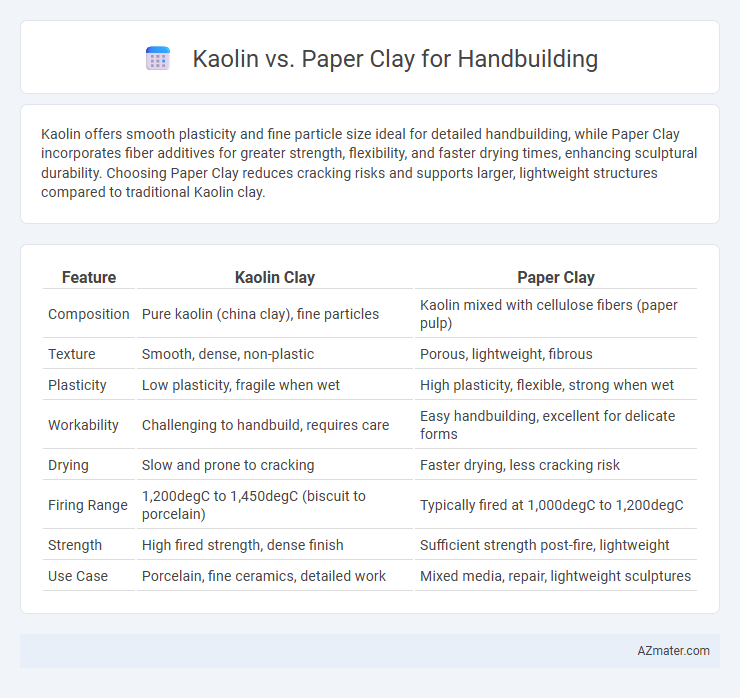Kaolin offers smooth plasticity and fine particle size ideal for detailed handbuilding, while Paper Clay incorporates fiber additives for greater strength, flexibility, and faster drying times, enhancing sculptural durability. Choosing Paper Clay reduces cracking risks and supports larger, lightweight structures compared to traditional Kaolin clay.
Table of Comparison
| Feature | Kaolin Clay | Paper Clay |
|---|---|---|
| Composition | Pure kaolin (china clay), fine particles | Kaolin mixed with cellulose fibers (paper pulp) |
| Texture | Smooth, dense, non-plastic | Porous, lightweight, fibrous |
| Plasticity | Low plasticity, fragile when wet | High plasticity, flexible, strong when wet |
| Workability | Challenging to handbuild, requires care | Easy handbuilding, excellent for delicate forms |
| Drying | Slow and prone to cracking | Faster drying, less cracking risk |
| Firing Range | 1,200degC to 1,450degC (biscuit to porcelain) | Typically fired at 1,000degC to 1,200degC |
| Strength | High fired strength, dense finish | Sufficient strength post-fire, lightweight |
| Use Case | Porcelain, fine ceramics, detailed work | Mixed media, repair, lightweight sculptures |
Introduction to Kaolin and Paper Clay for Handbuilding
Kaolin is a refined white clay prized for its smooth texture and plasticity, making it ideal for detailed handbuilding in ceramics. Paper clay incorporates cellulose fibers, enhancing strength and flexibility while allowing for thinner walls and faster drying times. Both materials offer unique advantages in handbuilding, with kaolin providing purity and finesse, and paper clay delivering durability and versatility.
Key Properties of Kaolin in Handbuilding
Kaolin clay is prized in handbuilding for its fine particle size, high plasticity, and smooth texture, which enhance workability and detail in sculpture. Its low iron content ensures a pure white firing color, making it ideal for surface decoration or glazing. Kaolin's refractory nature allows it to withstand high firing temperatures without warping or cracking, providing durability and strength to handbuilt ceramic pieces.
Unique Characteristics of Paper Clay
Paper clay contains cellulose fibers that enhance its tensile strength and flexibility, allowing for thinner, lighter handbuilt forms compared to kaolin. Unlike kaolin's fine, pure white clay body, paper clay's fibrous content reduces cracking during drying and firing, making it ideal for delicate or complex sculptures. This increased durability and shrinkage resistance provide artists with greater creative freedom and improved repairability in handbuilding projects.
Workability: Kaolin vs Paper Clay
Kaolin clay offers a smooth, fine texture with low plasticity, making it less flexible and prone to cracking during intricate handbuilding. Paper clay contains cellulose fibers that enhance workability by increasing strength and flexibility, allowing for better attachment of pieces and reduced drying cracks. The choice between kaolin and paper clay hinges on the desired balance of sculptural detail and structural durability in handbuilding projects.
Strength and Durability Comparison
Kaolin clay, rich in fine particles and low in impurities, offers excellent plasticity and smooth texture but tends to be less durable when dried, often requiring higher firing temperatures for strength. Paper clay incorporates cellulose fibers that enhance tensile strength and reduce cracking during drying, providing superior durability and flexibility ideal for handbuilding techniques. The fiber reinforcement in paper clay significantly improves its structural integrity compared to traditional kaolin, making it more resilient to damage throughout the sculpting and drying processes.
Drying and Shrinkage Differences
Kaolin clay exhibits slower drying rates and lower shrinkage compared to paper clay, making it ideal for delicate handbuilding projects that require minimal warping. Paper clay incorporates cellulose fibers, which enhance moisture retention and reduce cracking during drying, resulting in better structural integrity. Understanding these drying and shrinkage differences helps artisans choose the appropriate clay type based on project durability and finish requirements.
Surface Texture and Finish Quality
Kaolin offers a smooth, porcelain-like surface texture that is ideal for fine detail and a high-quality, glossy finish after firing. Paper clay incorporates cellulose fibers, providing a rougher texture that enhances strength and flexibility but results in a more matte, textured finish. Surface finish quality in handbuilding depends on the desired aesthetic and functionality, with kaolin achieving a sleek, refined look and paper clay delivering a rustic, tactile feel.
Firing Temperatures and Results
Kaolin, a pure white clay with high alumina content, typically fires at cone 6 to cone 10 (2232degF to 2345degF), producing a dense, hard, and smooth final piece ideal for detailed handbuilding. Paper clay, a mix of kaolin or other clays with paper fibers, can be fired at a lower range from cone 04 to cone 6 (1945degF to 2232degF) and offers improved drying strength and reduced cracking, resulting in lighter, more flexible forms before firing. The firing temperature directly affects the durability and texture, with kaolin yielding more vitrified, porcelain-like qualities and paper clay allowing greater artistic experimentation with surface textures and shapes.
Suitability for Beginners and Experienced Artists
Kaolin clay, known for its fine particle size and smooth texture, offers excellent plasticity that benefits beginners mastering handbuilding techniques by providing easy shaping and minimal cracking. Paper clay, reinforced with cellulose fibers, enhances strength and flexibility, making it ideal for experienced artists seeking to create larger, more complex forms with reduced drying time and fewer structural issues. The choice between kaolin and paper clay depends on the artist's skill level and project requirements, with kaolin favored for precision and paper clay preferred for durability and versatility.
Choosing the Right Clay for Your Handbuilding Project
Kaolin offers a smooth, plastic texture ideal for detailed handbuilding and porcelain-like finishes, while paper clay combines kaolin with cellulose fibers for increased strength and flexibility, reducing cracking during drying. Choosing the right clay depends on your project's requirements: kaolin suits delicate, refined pieces, whereas paper clay excels in larger or more intricate structures needing extra support. Consider drying time, surface texture, and firing temperature compatibility when selecting between kaolin and paper clay for optimal results.

Infographic: Kaolin vs Paper Clay for Handbuilding
 azmater.com
azmater.com